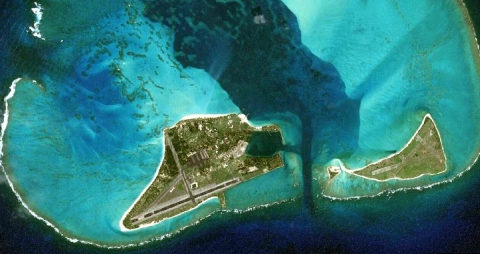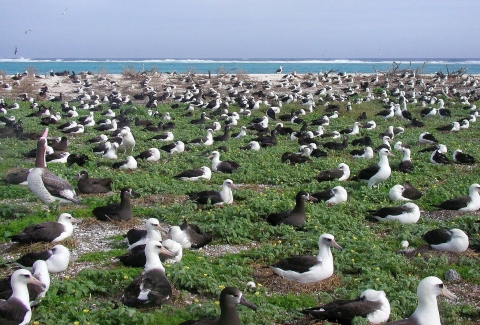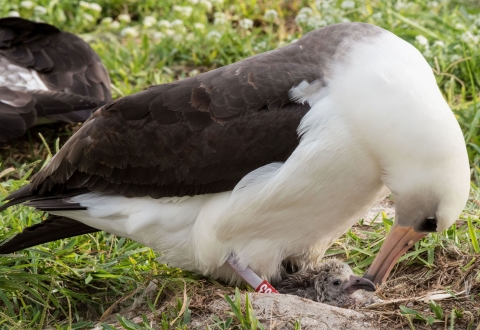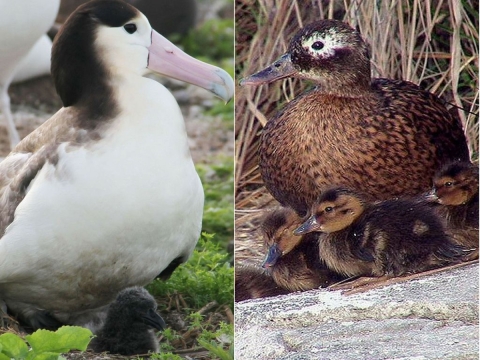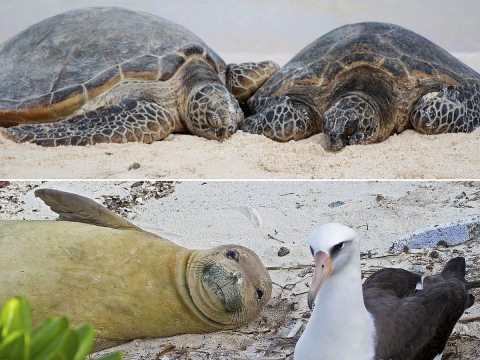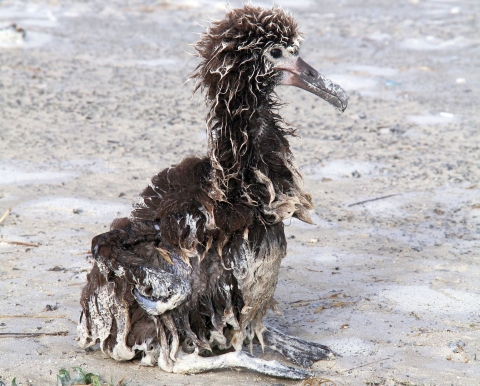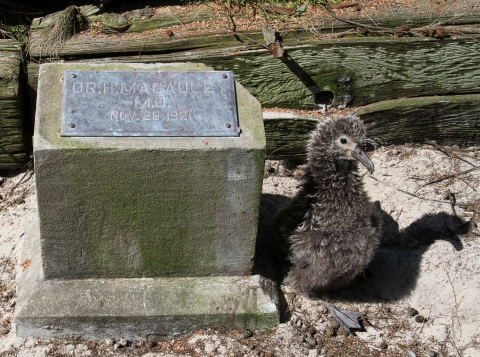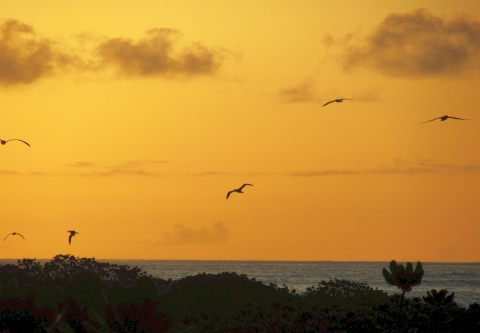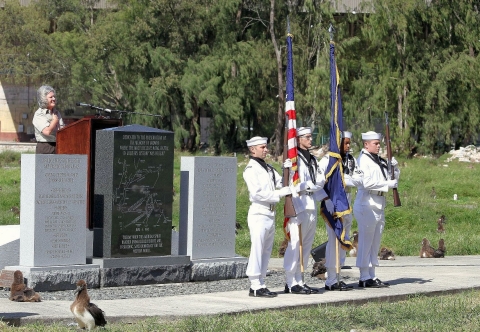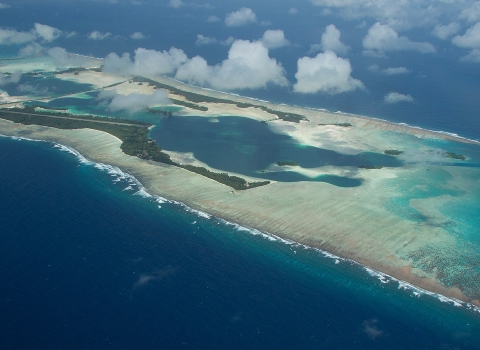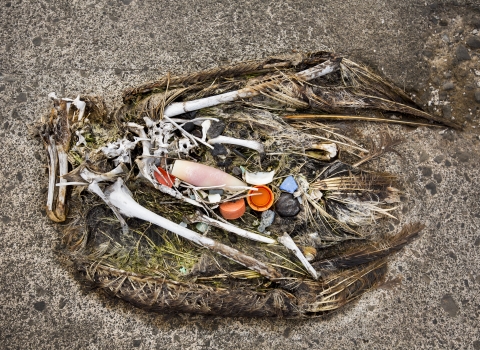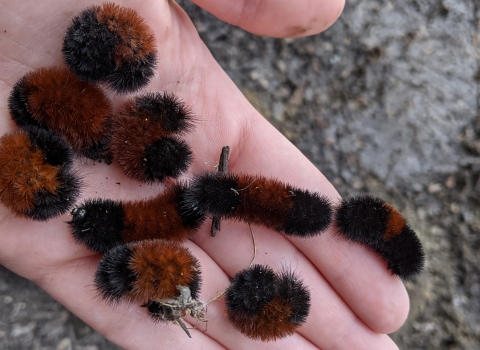Midway Atoll is well known as the site of a June 4-7, 1942 battle that was the turning point of World War II in the Pacific.
The inscription on the marker in the photo above reads, in part: “After this Battle of Midway, the United States and its allies forged ahead with ever increasing strength and confidence to final victory.”
What follows are a handful of lesser-known facts about Midway, which is home to Midway Atoll National Wildlife Refuge and Battle of Midway National Memorial.
Midway Atoll has a rich history. The first visitors likely were Polynesians/Hawaiians exploring the Pacific in voyaging canoes. No physical evidence of their visits remains, but historical accounts mention distant low-lying islands with abundant birds and turtles. Captain N.C. Brooks was the first Westerner to “discover” the unoccupied atoll in 1859, and the United States took possession of it soon thereafter. In 1903, Midway became the final link in a global telegraph system, inaugurated by a message from President Theodore Roosevelt. In the late 1930s, the atoll became a landing site for Pan Am Clippers crossing the Pacific Ocean. From 1941 until 1993, it housed a military base. It became a full-fledged national wildlife refuge national wildlife refuge
A national wildlife refuge is typically a contiguous area of land and water managed by the U.S. Fish and Wildlife Service for the conservation and, where appropriate, restoration of fish, wildlife and plant resources and their habitats for the benefit of present and future generations of Americans.
Learn more about national wildlife refuge in 1996, when President Bill Clinton signed Executive Order 13022, which transferred it from the Navy to the Department of the Interior. The U.S. Fish and Wildlife Service manages the refuge.
When Midway was a naval facility, it often housed more than 5,000 residents. Today, roughly 40 refuge staff members, contractors and volunteers live there at any given time.
Midway Atoll National Wildlife Refuge is home to 21 breeding seabird species – about 3 million individual birds – including Laysan, black-footed and short-tailed albatross, and Laysan ducks. The Hawaiian name for Midway Atoll is Pihemanu, which means “the loud din or sound of birds.”
Wisdom, a Laysan albatross, is at least 70 years old. She has raised at least 10 chicks since 2006 and as many as 40 in her lifetime.
The Laysan duck is the most endangered duck in the Northern Hemisphere. In 1911, there was just one known breeding female in the only known wild population on Laysan Island, 750 miles from Midway Atoll. In 2004 and 2005, 42 wild Laysan ducks were relocated from Laysan to Midway Atoll. The re-establishment of a second population at Midway reduced the risk of extinction should a catastrophic event occur at Laysan Island, such as a hurricane or avian disease.
In January 2011, for the first time in recorded history, a short-tailed albatross hatched outside of the islands surrounding Japan. The hatching occurred on Midway Atoll’s Eastern Island.
Midway Atoll National Wildlife Refuge is part of Papahānaumokuākea Marine National Monument. Marine national monuments help conserve the ocean ecosystem’s delicate balance for fish, plants, seabirds, marine mammals, corals, microorganisms – and humans. Papahānaumokuākea is the largest of the four marine national monuments in the Pacific Ocean.
Annually, adult albatrosses bring an estimated 5 tons of plastic – mistaken for floating fish eggs, squid or other seafood – to Midway Atoll and feed it to their chicks. Almost all chicks hatched at Midway have plastic in them. To learn more about the marine debris problem and what you can do about it, see “Oceans of Trash” or this story about a spring cleanup within Papahānaumokuākea Marine National Monument.
On March 10, 2011, at 11:36 p.m. local time, a tsunami generated by a powerful, magnitude-9.0 earthquake off Japan struck Midway Atoll. The tsunami completely washed over Spit Island and covered about 60 percent of Eastern Island and 20 percent of Sand Island. Tens of thousands of birds died. Fortunately, no people were hurt.
By the way, a National Oceanic and Atmospheric Administration (NOAA) tide/tsunami station at Midway acts as an early warning to the main Hawaiian Islands. It sends data in real time to Honolulu, 1,200 miles to the southeast.
There is a small cemetery on Sand Island. It is known as the Doctors’ Cemetery because four medical doctors are buried there. Their dates of death range from 1906 to 1950.
Henderson Field on Sand Island is operated by the U.S. Fish and Wildlife Service and the Federal Aviation Administration as an emergency landing runway for commercial and military flights. The U.S. Marine Corps F/A-18 fighter above made an emergency landing in July 2015. A year earlier, a United Airlines Boeing 777 – en route from Honolulu to Guam with 348 passengers aboard – was diverted to Midway for a nighttime emergency landing. In 2011, a Delta Air Lines Boeing 747 bound from Honolulu to Osaka, Japan, with about 380 people aboard made an emergency landing because of a cracked windshield (video).
On any given day, Midway Atoll is the last piece of U.S. territory on which the sun sets. Midway Atoll is just 140 nautical miles east of the International Dateline. Kure Atoll, also U.S. territory, is just 48 nautical miles east of the dateline but, surprisingly, is in a time zone one hour ahead of Midway. So Kure’s day ends earlier.
In 2000, the Secretary of the Interior designated the lands and waters of Midway Atoll National Wildlife Refuge as the Battle of Midway National Memorial.
The Battle of Midway itself was fought mostly at sea. Only 30 minutes or so of fighting occurred on the atoll. The battle produced one Medal of Honor recipient, Marine Corps Captain Richard E. Fleming. However, Captain Fleming was not the first Midway recipient of the medal.
Marine Corps 1st Lieutenant George H. Cannon died at Midway after he was wounded and stayed at his post during a bombardment of the atoll on December 7, 1941 – the same day Pearl Harbor was attacked. He was posthumously awarded a Medal of Honor for his heroic actions.


